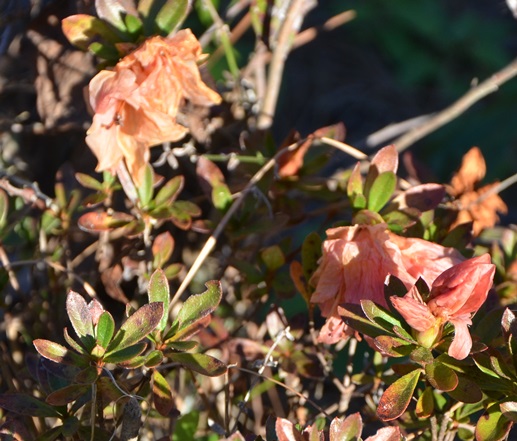
by Les Harrison | Feb 3, 2017
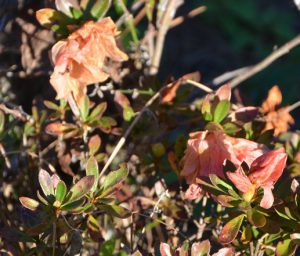
Photo caption: Local azaleas were prematurely blooming
This winter’s exceptional weather has deceived some popular springtime ornamental shrubs and fruit trees into flowering prematurely. Azaleas, for example, began blooming because of winter temperatures mush warmer than average.
There are number of variables which determine when a plant will bloom each year, including the sun, water, and air temperature. To understand why the plants bloom, there should be an understanding of “photoperiodism”, meaning the effects of light and darkness on some plant species.
Certain plants respond to the day length. Some are long day plants which flower in spring and summer, and some are short day plants flowering in fall and winter. Then there are plants which will bloom in any season, identified as day neutral plants.
Long and short day plants will not be directly affected by prevailing weather conditions. For example chrysanthemums, which are short day plant naturally bloom in winter.
These plants can be forced to bloom in summer by keeping them in a dark room for 12 hours a day for several weeks. Many nurseries supplying florist uses this technique and utilize greenhouses with blackout systems. They also use grow lights to produce early season blooms on spring/summer flowers sold for Valentine Day.
For those neutral day plants there is “vernalization”. These plants must be exposed to cold weather to some greater or lesser amount.
Most temperate fruit trees need exposure to cold temperatures. When winters are too mild or contain intermittent warmer periods, dormancy is prematurely terminated and bud break starts.
Most of the exposed buds of these fruit trees can survive freezing temperatures, but many of their flowers will be killed if exposed to a late arriving hard freeze or frost.
After the freeze most of the flowers may appear normal, but the center part of the flower where the reproductive organs reside are killed and result in no fruit formation. Covering plants in-bloom provides some freeze protection.
With a warm early winter, like December 2016, there has been irregular and premature flowering.
Another consideration is fruit trees or shrubs pruned too early winter. Warm weather combined with the pruning stimulates the growth of new shoots.
There is a hormone produced in lateral or terminal shoot buds which travels down the shoots inhibiting their growth. When the terminal shoots are pruned too early the growth inhibiting hormone is removed.
The warm days during winter may cause these newly pruned plants to form new shoots. The new growth is tender and very susceptible to freeze injuries. Pruning in late January or February will likely deliver the best results.
For shrubs like azaleas and gardenias, flower buds are set in summer, long before they can be identified by most people. Losing the buds, no matter the cause, after midsummer drastically decreases the number of flowers the following spring.
To learn more about the spring bloom for 2017, visit the UF/IFAS County Extension website
By: Gohar Umar, FAMU Extension Horticulture Specialist, and Les Harrison, Wakulla County Extension Director
Photo caption: Local azaleas were prematurely blooming
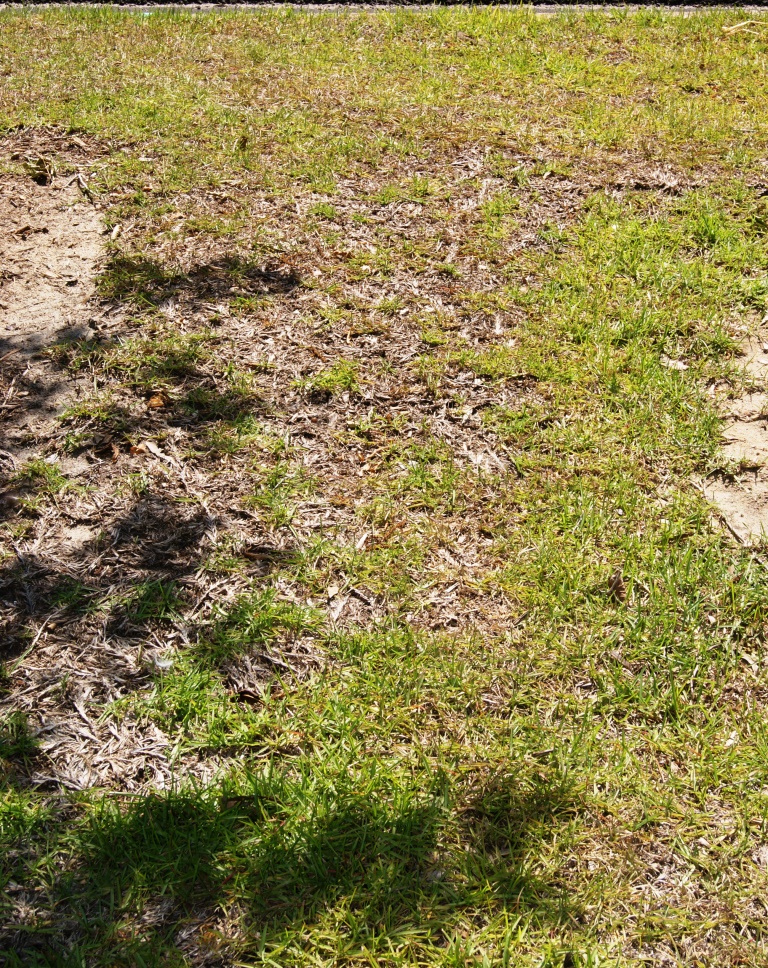
by Sheila Dunning | Feb 3, 2017
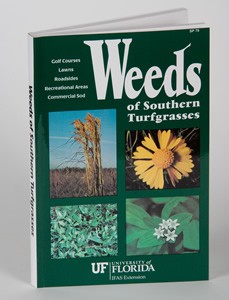 Remember last summer? The hot, dry days. Grass drying up and turning brown. Yet, the weeds are green and doing fine. However, every herbicide label warns against applying when the temperatures are above 85 degrees and especially under drought conditions. Those weeds flourished and dispersed seed everywhere. Now, they are just sitting there ready to sprout again.
Remember last summer? The hot, dry days. Grass drying up and turning brown. Yet, the weeds are green and doing fine. However, every herbicide label warns against applying when the temperatures are above 85 degrees and especially under drought conditions. Those weeds flourished and dispersed seed everywhere. Now, they are just sitting there ready to sprout again.
It’s time to start thinking about weed prevention. Pre-emergent herbicides need to be applied prior to seed germination. Late winter is the time to focus on summer annual weeds. The narrow window of application is challenging. Homeowners often wait too late into spring to put out preventative products. A general rule of thumb for pre-emergent herbicide timing is February 15 – March 1 in North Florida.
However, weed seeds germinate in response to soil temperature, not calendar dates. By monitoring day time temperatures, one can determine a more effective application date. When there are 4-5 consecutive days that reach 65 to 70 degrees weeds will germinate. This generally coincides with the first blooms appearing on azaleas and dogwood. With a warm winter it may occur as early as mid-January.
Some of the active ingredients in pre-emergent herbicides include dithiopyr, isoxaben, oryzalin, pendimethalin, prodiamine and simazine. Always read the label for specific weed controlled and observe all directions, restrictions and precautions.
Weed and feed products that contain nitrogen are not suitable as pre-emergent herbicides. Irrigation before and after application is necessary to activate these products. The chemical binds to soil particles, creating a barrier that remains effective for 6-12 weeks. Reapplication will be necessary for season long control, especially with constantly fluctuating winter temperatures. Now is the time to purchase pre-emergent herbicides and prepare to apply them. For more information on weed control in lawns go to: http://edis.ifas.ufl.edu/ep141
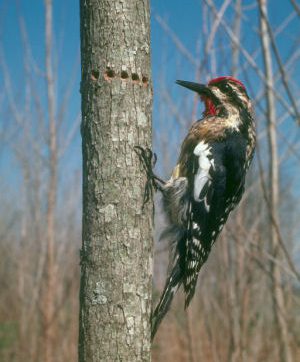
by Daniel J. Leonard | Feb 3, 2017
Have you noticed strange rings of pencil-sized holes on the trunks of certain trees in your landscape recently? If so, take heart that these holes are not emanating from an infestation of destructive insects but rather from a perfectly native, rather attractive migratory woodpecker, the Yellow-Bellied Sapsucker (Syphrapicus varius)!
The Sapsucker is a smallish bird with a chisel-like bill, easily distinguishable by bold black and white face stripes and a conspicuous bright-red crown and throat. If you have any problem identifying it by its features, look to its migration pattern, the Yellow-Bellied Sapsucker overwinters in mild winter areas of the Americas (like Florida’s Panhandle) and causes damage during this period (roughly December through March). If you notice a bird wreaking havoc on your backyard flora this afternoon, it is likely a Yellow-Bellied Sapsucker!
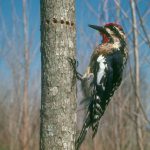
Yellow-bellied sapsucker (male) on pecan
James Solomon, USDA Forest Service, Bugwood.org
Like other members of its family, this woodpecker makes a living by “pecking” holes in trunks of trees and small shrubs about chest-high from the ground and feeds on sap and the occasional insect drawn to the sap. Fortunately, the damage is not usually harmful to the tree except in severe cases where the trunk may be girdled or secondary infection occurs from pests/diseases entering the tree through the holes. Unfortunately for Florida gardeners, this little bird has preferences in which trees it attacks, the majority of which are favorite landscape plants. For example, heavy feeding has been observed, both anecdotally by the author and more scientifically by researchers and birding enthusiasts, on Red Maple, Pecan, Chinese Elm, American Holly, Pine and Live Oak. They also really seem to enjoy any soft-wooded shrub limbed-up in a treelike form like Waxmyrtle, Viburnum and Dahoon Holly. Talk about frustrating!
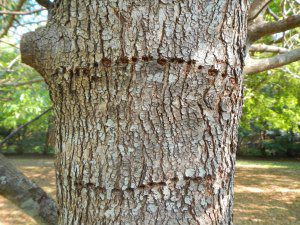
Sapsucker damage in a tree trunk.
Photo courtesy of Mississippi State Extension.
After learning that Sapsucker damage is not usually harmful, most homeowners opt to not control the birds’ feeding. However, if the aesthetic damage is not acceptable in your landscape, there are a few semi-effective control options and a host of other, less-effective home remedies. Wrapping the trunks of favored species with a loose, thick material such as burlap or felt is the preferred method of many ornamental nurseries and tree farms due to the material’s reusability and ease of removal after the migration has passed. Other commercial enterprises have had mixed success with hanging visually frightening CDs, pie plates and the like from low branches. Even less success has been seen with other homemade “cures” ranging from rubbing trunks of favored trees with Ivory soap to the use of sticky materials to deter perching. Shooting or trapping Yellow-Bellied Sapsuckers is not permitted as the birds are protected by state and federal wildlife law. As always, please contact your local UF / IFAS Extension office for advice and recommendations for other methods of discouraging unwanted bird visits!
Happy New Year and good gardening!
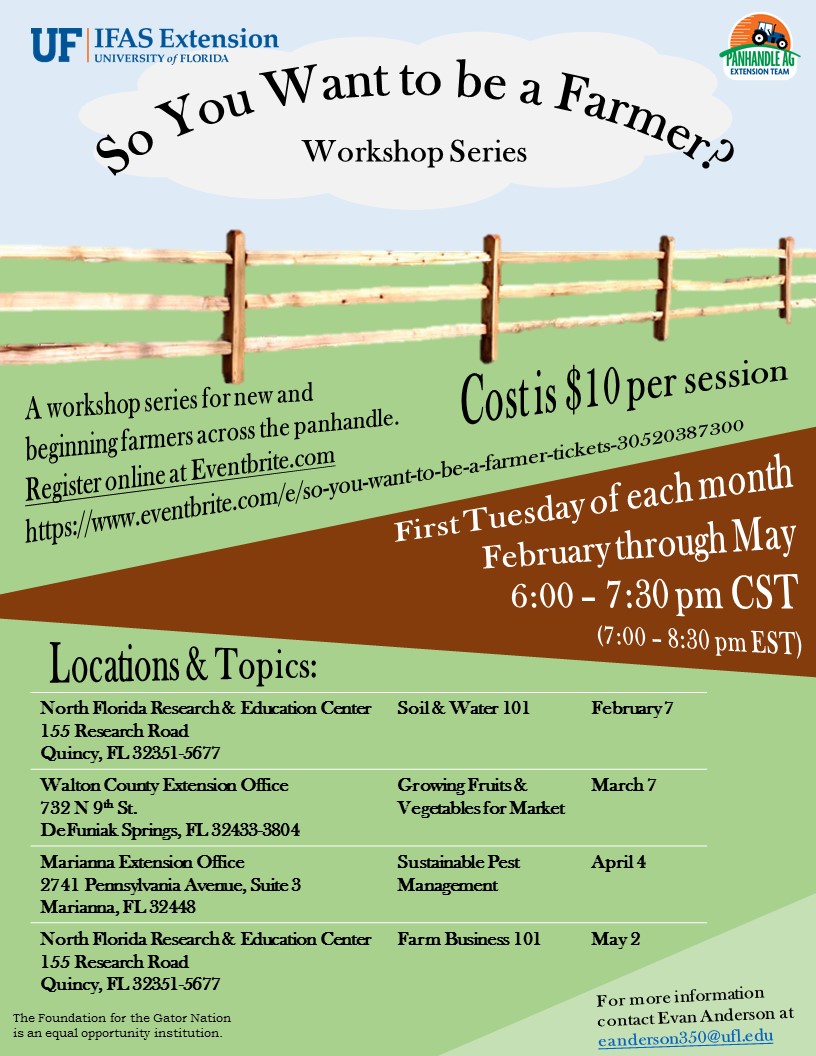
by Molly Jameson | Jan 26, 2017
Are you an avid gardener and looking to step it up a notch? Are your gardening eyes bigger than your dinner plate? If you have ever considered selling your bounty for market, you will certainly need to do your homework! One such step you can take is to attend the UF/IFAS Panhandle Extension Team’s So You Want to be a Farmer? Workshop Series.
There’s a lot to know if you want to get into this business! This series aims to introduce new or potential farmers to innovative and environmentally safe production practices, concepts of soil and water management, integrated pest management, how to grow for a farmers’ market, and farm financial management.
Agricultural professionals are actually in high demand. There is an estimated 60,000 highly skilled jobs in agriculture available annually, but only about half of these positions are being filled by graduates in agricultural fields. Additionally, Florida’s farmers are an aging group, and there was an 8% decrease in the number of farms and 26% decrease in acres of cropland from 2002 to 2012.
Fortunately, demand has greatly increased in recent years for locally produced specialty crops, meats, and dairy. There has also been an increase in the number of direct marketing opportunities and small farmers have been able to adopt new technologies, such as season extension techniques and local online marketing, to generate more revenue on small acreages.
The UF/IFAS Extension Panhandle Agriculture Team is hosting the So You Want to be a Farmer? Workshop Series to assist beginning or novice farmers as they navigate the many challenges of getting started.
If you are interested in attending, please register on the So You Want to be a Farmer? Eventbrite page. The cost is $10 per session, with sessions at multiple locations within the east Florida Panhandle.
Please see workshop dates and further details below:

by Larry Williams | Jan 26, 2017
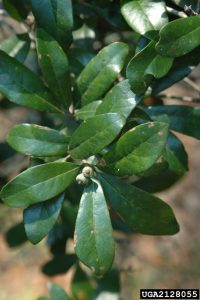
Live oak with immature acorns. Photo credit: Wendy VanDyke Evans, Bugwood.org.
Do you have more acorns than you know what to do with? When oaks produce loads of acorns, it sometimes is called a “mast” year. Do you remember the oak tree pollen and all those catkins that fell from oaks earlier in spring?
Catkins are the male flowers in oaks. Some people refer to them as tassels or worms. The airborne pollen from these catkins were part of the reproductive process in fertilizing the female oak flowers that ultimately resulted in all of these acorns. Oaks produce separate male and female flowers on the same tree. Female flowers in oaks are very small. You’d have to look very close to see them. Many oaks did well in their reproductive efforts this spring. Acorns are oak seeds. This entire process is part of the cycle of life.
There are theories about mast years, wildlife’s use of these acorns and what gardeners can expect next year as a result of this year’s abundant acorn crop. Timing of mast years is still a mystery. Numerous theories exist ranging from weather to geography to the life cycles of predators.
The most likely reason for high production seems to be weather-related. When oak trees have favorable weather at the time of oak flowering and good growing conditions, the mast seems to be increased.
But mast years happen irregularly, making it difficult to understand what causes a mast year. Heavy acorn production can occur twice in a row or it might be separated by several years or more. There’s no good way to predict it.
Mast years are important to wildlife, as acorns are an important food for many animal species. In low crop years, birthrate for some wildlife species, such as squirrels, will decline the following year. This also may involve increased competition for food and survival rates. The recent crop means that more young are likely to be produced by animals that forage for acorns.
Wildlife play a big role in forest regeneration. When acorns drop out of oaks, many animals help distribute these seeds. Squirrels can bury hundreds of acorns. Some of these acorns germinate and grow to become the next generation of oak trees. Some will be eaten by birds, bears, deer, rodents, including squirrels, and other wildlife. Rodents are in turn eaten by carnivores and deer browsing shapes which kinds of plants become established and survive. All those acorns have far-reaching impact on wildlife and our forests.
So, try to keep this in mind as you are fussing with all those acorns in your lawn and landscape this season.









